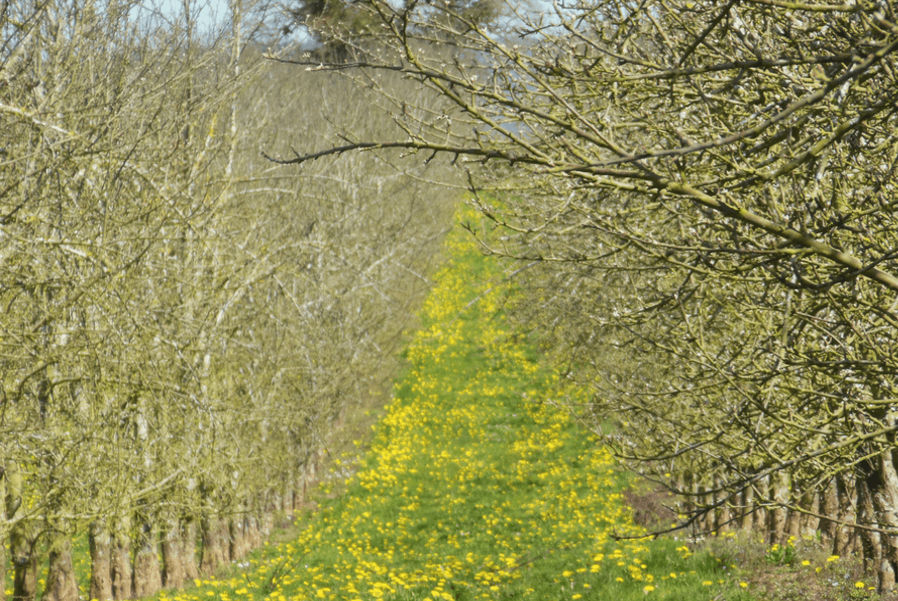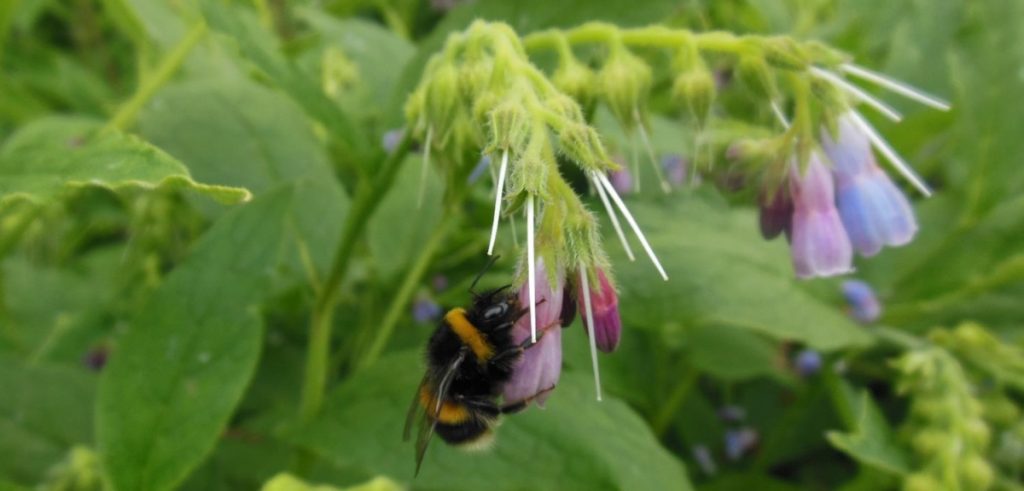Flower strips at field edges are quite popular. They’re promoted as “bee-friendly”, as increasing biodiversity in farmland. Noble goals. However, it’s a legitimate question if this is true. Some studies show contradicting results. It’s also a common criticism that with flowering strips you first attract pollinators, which are then killed by pesticide applications. This is the reason why orchard growers, for instance, have to mow between the rows before they apply certain pesticides. This is considered a mitigation measure to avoid poisoning.
There’s another side of this, though. Fruit orchards need pollinators. And pollinators need flowers (and nesting habitat, we’ll come to that). You may say, ok, but the orchards provide flowers, don’t they? Well, yes and no. They obviously do provide flowers, but not all the time. In addition, the pollinators should be in the crop already, when it begins to bloom. For the simple reason, that cherry or apple flowering is quite short*. So, if the apple tree itself must attract the pollinators, the consequence could be insufficient pollination. It can take some time, depending on how many pollinators are around. Which, again, depends on the habitat around the orchards.
Cider apple orchards and bee diversity
During spring in 2013 and 2014, I was in Herefordshire (UK) to study the bee diversity in cider apple orchards. Together with two “field assistants”, I started the study before the apple bloom. Dandelion was in flower on the strips of grass between the rows. Many other wildflowers were blooming, too, but less dense than dandelion. We observed that in the orchards with plenty of flowers we saw more bees and more species. Mainly mining bees, with plenty of nests along the rows. It was then when I got this idea of the grass strips with dandelion being a highway into the apple orchard. In my “what bees need”-series last year, I told you that the nests are the centre of bee activity. Some species fly only a few hundred meters around them.
So, the bees hatching from those nests began foraging on the dandelion and were still provisioning their own nests when the apple started to bloom. We mostly saw mining bees, as well as on the dandelion before. A PhD student (now pollination scientist), Alistair Campbell, working at some of the orchards we studied, confirmed my impression with numbers: Wild bees (mainly mining bees) visited apple flowers more often the more dandelion was present on the orchards. The flowering strips he sowed into the orchards increased the abundance of wild insects. But they didn’t fit the mining bees, which were the main pollinators. Therefore, the pollination services were not improved by the flower strips. He concluded that flower mixtures may help to boost the abundance of existing species. However, only enough habitat around the orchards could preserve the diversity necessary for pollination.
Flower strips – all the same?
There you have it: It sounds so easy, but it isn’t. Flower strips did increase the abundance of wild insects but didn’t help with pollination in this case. Other studies, however, find a positive relationship between sown flowers and pollination efficiency. You now may ask: But flowers are good for pollinators, aren’t they? Yes, of course, they are. However, not every flower for every pollinator. It depends. Each species has its preferences; some feed on many different flowers, others have a narrower range of plants they feed on. Each crop will have different pollinators that are most efficient to do the job. The composition of flower strips must consider that – they’re not all the same. In apple orchards, the mixture should include early flowering species. To attract pollinators that are already there when the apple starts. Later flowering crops need another pollinator community that is attracted by other flowers.
This is most probably a reason why some studies find flower strips to be helpful and others don’t. A recent review looks closer at this: Lowe and colleagues analysed a huge number of studies dealing with flower plantings a field edges. Overall, they found that these strips increase both species richness and abundance of pollinators. Like in Alistair Campbells study, however, the effectiveness of crop pollination was inconsistent. This isn’t an argument against sowing flowers on field edges. It only confirms that there’s no “one-fits-all” solution. There are also two aims here, that aren’t necessarily congruent: bee diversity and crop pollination. In the best case, the flower plantings help both. But, as we saw with the apple example, this needs some thought beforehand.
Factors influencing the effectiveness of flower strips
There are two factors that also influence how effective flower strips are: Perennial plantings at their mature stage have the most abundant and species-rich bee communities. I told you about this aspect in my agriculture series last year. A reason for this could be that bees prefer areas with high flower density. This usually increases in established plant communities. In addition, flower plantings were most successful when (semi-)natural habitat was nearby. This is simple biogeography: A flower strip in a “desert” without flowers is like a remote island. It’s difficult to get there.
Interestingly, Lowe and her co-authors didn’t find an effect of the planting size on the wild bee abundance and species richness. This means that even smaller strips could already help – if perennial and some other habitats are nearby. This is good news for the farmers: they often plant flowers at unused field margins. Which often isn’t the largest area. However, to make the plantings effective, some thought must go into it. Otherwise, they won’t help. After all, flower strips aren’t an end in themselves. It’s about maintaining biodiversity in farmland and making sure the crop gets pollinated. This may mean a bit of thought beforehand, but in consequence better results for these goals.
*It’s not only the time the flower is there itself, but also if the flower is receptive for pollination at the moment. Pollination biology is complex, but that may be the subject of another post.
This article is the start of a series on bee diversity. May includes two important dates for bees: first, there’s World Bee Day on the 20th. Two days later, May 22nd, is the International Day of Biodiversity. So, what better opportunity to write about biodiversity and bees?
It is also part of my quest against black and white thinking. Things are complex, but not necessarily complicated. If you need help with how to help pollinators and pollination in your crop, I’m here to help. A first 20-minute strategy call is free, to see how and if I can help you. I’ll be happy to help you with your problems, but if it doesn’t fit, that’s ok.



